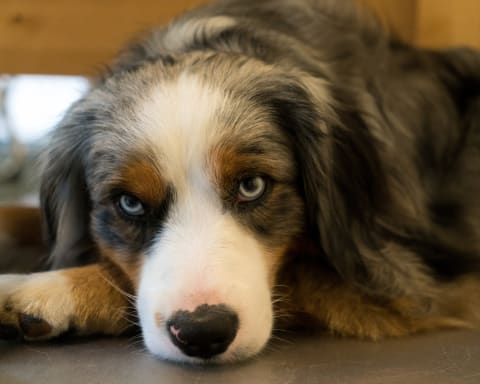What is TPLO Surgery?
TPLO (or Tibial Plateau Leveling Osteotomy) surgery is a common orthopedic surgery for dogs with a torn cranial cruciate ligament (the CCL, similar to the ACL in humans). It’s a very effective long-term solution for addressing this injury, and has been popular because of its quick recovery time and results.
The surgery changes the dynamics of the dog’s knee so the torn ligament isn’t needed. Because a dog’s knee is always bent at about 110 degrees, it’s always taking on load, or tension - which makes it vulnerable to injury (no wonder it’s the most common orthopedic injury in dogs).
A torn CCL for a dog is very painful as the femur will be rubbing on the back of the tibia, causing inflammation and discomfort. Chances are, your dog will be very reluctant to put any weight on that leg.
Procedure
With TPLO surgery, the bone is cut so the tibial plateau can be rotated where the tibia and femur work together. Part of the tibia will be removed and repositioned, and the femur won’t be able to slide backwards. Most importantly, the knee will be stabilized. The CCL ligament is no longer needed and the joint is stable again.
Here are a list of factors to think about when considering TPLO surgery. Think about your dog’s:
- Age
- Weight and size
- Activity level (Calm? Extremely active? In between?)
- After-surgery care
- Health (does he have any joint diseases?)
Recovering from TPLO Surgery: What to Do and What to Avoid
Though every dog is different, the first 12 weeks following surgery are a critical time, as full recovery may take anywhere from 8 weeks to 6 months. Your dog’s breed, size and age may affect recovery time. Though the bone graft will be secured by a plate and screws, it still needs post-surgical healing time. During this period, you should:
- Give the anesthesia time to wear off
- Keep surgical areas clean, covered and protected from infection
- Restrict physical activity to give bones time to heal but follow any recommended exercise routines
Keep in mind that avoiding infection and restricting physical activity during the recovery period are essential. Since dogs tend to heal quickly and crave physical activity, he could be up and raring to go before his body is physically ready. While walking for a few minutes at a time on-leash is advisable, avoid high-intensity activities such as running, jumping, playing with other dogs and even steep stairs.
Though you can likely leave your dog unattended during the day to go to work or school, he will still need potty breaks and exercise to avoid stiffness. By week 8, if all is well, the stitches should be ready to come out.
Potential Complications and What to Do
Though recovery from TPLO surgery is typically complication-free, you’ll want to call your veterinarian at the first sign of any of these symptoms:
- Infection or inflammation at incision site
- Refusal to put weight on recovering leg
- Diarrhea or vomiting
- Widely varying drinking and eating habits
- Missing staples
- Sensitivity to pain medications
- Constipation due to change in activity, healing or medication
If any of these signs appear, your veterinarian is a valuable resource - they may be able to diagnose the issue and recommend a solution.
Also remember that similar to people who are recovering from any procedure, dogs need activity, too. He’ll appreciate a few new toys and your doting attention as he recovers.
Diagnostics are part of our services. If you think your dog may have torn his CCL, contact our office as soon as possible to schedule an appointment, so it can be correctly diagnosed.
Looking for a vet in Flat Rock?
We're always accepting new patients, so contact our veterinary hospital today to book your pet's first appointment.Related Articles View All
Caring for a Dog With a Broken Jaw
Broken jaws are surprisingly common in dogs. In today's post, you will learn about the most common causes of broken jaws in dogs, how they can be repaired, and advice on caring for your pup as their jaw heals.
What does ringworm look like on a dog?
Contrary to its name, ringworm is a fungus comparable to athlete's foot. It produces infective seeds known as spores, which are highly resilient and difficult to eliminate in the environment. Ringworm may infect the skin of dogs and other animals. Today, our vets in Flat Rock discuss ringworm in dogs and what it looks like.
Cat Laryngitis: What to Do if Your Cat Loses Their Meow
Have you noticed that your kitty's meow has been reduced to a scratchy rasp, squeak or complete silence? Laryngitis in cats can be caused by numerous factors. Today, our Flat Rock vets share more about cat laryngitis symptoms, causes and treatments.
Should I get my indoor cat vaccinated? Why and when to do it
Our Flat Rock vets share some insights about why it's a good idea to have your indoor cat vaccinated against a number of serious conditions and diseases.

